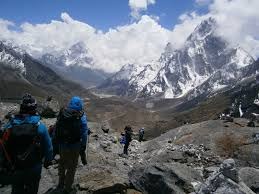Surviving altitude on the Everest Base Camp trek is essential for a successful and enjoyable journey. The trek to Everest Base Camp reaches elevations of up to 5,364 meters (17,598 feet), where the thin air can pose significant challenges to even the most experienced trekkers. Proper preparation and awareness of altitude-related issues are crucial for navigating these high altitudes safely.
One of the most important aspects of surviving altitude is acclimatization. As you ascend, your body needs time to adjust to the decreasing oxygen levels. This process involves gradually increasing your elevation and incorporating rest days, known as acclimatization days, to allow your body to adapt. For instance, a common practice is to ascend to a higher altitude during the day and then return to a lower altitude to sleep. This method helps your body produce more red blood cells to carry oxygen more efficiently. It is vital to follow a gradual ascent schedule and not rush the process, as this reduces the risk of altitude sickness.
Hydration and nutrition are also critical in high-altitude conditions. Mount Everest Base Camp Dehydration exacerbates the symptoms of altitude sickness, so drinking plenty of water is essential. Aim for at least 3 to 4 liters of water per day, and consider drinking herbal teas or soups to increase fluid intake. A well-balanced diet rich in carbohydrates and proteins helps maintain energy levels and supports overall health. Foods high in complex carbohydrates, such as whole grains and fruits, provide sustained energy and help your body cope with the physical demands of trekking at high altitudes.
Recognizing the symptoms of altitude sickness and knowing how to address them is crucial. Common symptoms include headaches, nausea, dizziness, and shortness of breath. If symptoms persist or worsen, it’s important to take action by halting your ascent and resting at your current altitude. Medications such as acetazolamide (Diamox) can help with acclimatization and alleviate symptoms, but they should be used under the guidance of a healthcare professional. In severe cases, descending to a lower altitude is the most effective treatment.
Physical fitness plays a significant role in your ability to handle high altitudes. Prior to the trek, engage in cardiovascular training to build endurance and strength. Activities such as hiking, running, and cycling improve your cardiovascular system and overall fitness, preparing your body for the demands of high-altitude trekking.
Mental preparation is another key component. High-altitude trekking can be mentally challenging, with long days and unpredictable weather conditions. Staying positive, setting realistic goals, and being prepared for the physical and mental demands of the trek can significantly impact your experience.
In summary, surviving altitude on the Everest Base Camp trek involves a combination of acclimatization, proper hydration and nutrition, recognizing and addressing symptoms of altitude sickness, physical fitness, and mental resilience. By incorporating these strategies, trekkers can enhance their chances of a safe and successful journey to one of the most iconic destinations in the world.
Introduction to Altitude and Its Effects
Altitude significantly impacts the body, particularly as trekkers ascend to higher elevations where the air pressure and oxygen levels decrease. At high altitudes, typically above 2,500 meters (8,200 feet), the reduced availability of oxygen can affect bodily functions, leading to various physical and physiological changes. As the elevation increases, the body must work harder to obtain sufficient oxygen, resulting in increased breathing rates and heart rates. This adjustment can strain the cardiovascular and respiratory systems, and individuals may experience a range of symptoms as their bodies acclimate to the reduced oxygen levels. Understanding how altitude affects the body is crucial for preparing for high-altitude treks, such as those to Everest Base Camp, where the elevation reaches up to 5,364 meters (17,598 feet). Proper preparation and awareness of these effects can help mitigate risks and improve overall trekking experience, allowing trekkers to navigate high-altitude environments more safely and effectively.
Understanding Altitude Sickness
Everest Trekking Altitude sickness, also known as acute mountain sickness (AMS), is a common condition that affects individuals who ascend to high altitudes too quickly. It occurs because the body has not had enough time to adjust to the lower levels of oxygen found at higher elevations. Symptoms of altitude sickness can range from mild to severe and include headaches, nausea, dizziness, and fatigue. In more severe cases, it can progress to high-altitude pulmonary edema (HAPE) or high-altitude cerebral edema (HACE), which are life-threatening conditions requiring immediate medical attention. Preventing altitude sickness involves a combination of gradual acclimatization, proper hydration, and awareness of one’s physical condition. By understanding altitude sickness and its causes, trekkers can take proactive steps to reduce the risk and enhance their ability to enjoy high-altitude treks.
Symptoms of Acute Mountain Sickness (AMS)
Acute Mountain Sickness (AMS) manifests through a range of symptoms that typically appear within a few hours after ascending to high altitudes. Common symptoms include headaches, which can range from mild to severe, nausea, and vomiting. Trekkers may also experience dizziness, fatigue, and difficulty sleeping. These symptoms occur as the body struggles to cope with the reduced oxygen levels at higher elevations. Other signs may include a loss of appetite and general malaise. While AMS is usually mild and can resolve with proper acclimatization and rest, it is essential to monitor symptoms closely. If symptoms persist or worsen, it is crucial to descend to a lower altitude and seek medical advice. Early recognition and management of AMS can prevent the condition from progressing to more severe forms of altitude sickness, such as HAPE or HACE.
Acclimatization Strategies
Effective acclimatization is key to preventing altitude sickness and ensuring a safe and enjoyable trek in high-altitude environments. The process involves gradually ascending to higher elevations to allow the body time to adjust to reduced oxygen levels. A common strategy is to follow a gradual ascent schedule, where trekkers increase their altitude in small increments and include rest days at intermediate elevations to facilitate adaptation. For example, it is recommended to spend a day or two at a lower altitude before reaching higher points, a method known as the “climb high, sleep low” approach. During these acclimatization days, trekkers can make short excursions to higher elevations and return to lower altitudes to sleep. This strategy helps stimulate the production of red blood cells, improving oxygen transport throughout the body. Additionally, trekking at a slower pace and avoiding overexertion can aid in the acclimatization process and reduce the risk of altitude sickness.
The Importance of Hydration
Hydration plays a critical role in managing altitude sickness and maintaining overall health during high-altitude treks. At high elevations, the body loses fluids more rapidly due to increased breathing rates and dry air. Proper hydration helps to prevent dehydration, which can exacerbate symptoms of altitude sickness such as headaches and dizziness. It is recommended to drink at least 3 to 4 liters of water per day while trekking at high altitudes. Consuming fluids regularly, even if you do not feel particularly thirsty, is essential to keep the body well-hydrated. In addition to water, herbal teas and soups can also contribute to fluid intake. Maintaining hydration supports the body’s ability to adjust to lower oxygen levels and can improve overall physical performance and well-being. Proper hydration, combined with other acclimatization strategies, helps trekkers manage the challenges of high-altitude environments and enhances their trekking experience
Nutrition Tips for High Altitude
Nutrition plays a pivotal role in managing the physical demands of high-altitude Short Everest trekking and supporting overall health. At high elevations, your body requires more energy to function due to the increased effort needed for breathing and physical exertion. A diet rich in carbohydrates, proteins, and healthy fats is essential for maintaining energy levels and aiding recovery. Carbohydrates, such as whole grains, fruits, and vegetables, provide sustained energy, while proteins from lean meats, beans, and nuts support muscle repair and endurance. Healthy fats, found in foods like avocados and nuts, are also crucial for long-term energy. Additionally, consuming foods that are high in iron, such as red meat and leafy greens, can help improve oxygen transport in the blood, which is beneficial at high altitudes. Meals should be frequent and balanced to keep energy levels stable. It is also advisable to avoid heavy, greasy foods that can be harder to digest at higher elevations. Proper nutrition, combined with adequate hydration, helps the body adapt to the demands of high-altitude trekking and reduces the risk of altitude-related issues.
Breathing Techniques for Better Oxygen Flow
Breathing techniques can significantly enhance oxygen intake and improve overall performance during high-altitude trekking. One effective technique is diaphragmatic breathing, which involves deep, slow breaths that engage the diaphragm rather than shallow chest breathing. This method maximizes lung capacity and increases the amount of oxygen absorbed. Another technique is paced breathing, which involves breathing in a controlled manner, such as inhaling for a count of four and exhaling for a count of six. This helps regulate breath rate and ensures a steady oxygen supply. Additionally, practicing deep, rhythmic breathing while trekking at a slower pace can prevent overexertion and improve oxygen flow. Conscious breathing helps manage the physical stress of high altitudes and supports better acclimatization. Regular practice of these techniques before and during the trek can enhance respiratory efficiency and overall trekking comfort.
Medication Options for Preventing AMS
Medication can be a useful tool in preventing and managing Acute Mountain Sickness (AMS) during high-altitude treks. Acetazolamide (Diamox) is a commonly prescribed medication that helps speed up acclimatization by increasing the amount of oxygen available to the body. It works by stimulating the respiratory system, which helps counteract the effects of reduced oxygen levels at high altitudes. Typically, it is taken a day or two before ascending and continued for a few days during the trek. Another medication, dexamethasone, is used for more severe symptoms of altitude sickness and is usually prescribed by a healthcare professional. While medications can aid in acclimatization, they should be used as part of a comprehensive approach that includes gradual ascent, proper hydration, and monitoring for symptoms. It is essential to consult with a healthcare provider before using any medication, especially in high-altitude environments.
Signs to Descend: Knowing When to Turn Back
Recognizing when to descend is crucial for ensuring safety during high-altitude trekking. EBC Trek Symptoms that indicate the need to turn back include severe headaches that do not respond to medication, persistent nausea and vomiting, difficulty breathing, and extreme fatigue. Signs of more severe conditions like High-Altitude Pulmonary Edema (HAPE) and High-Altitude Cerebral Edema (HACE) include a cough with pink or frothy sputum, confusion, and loss of coordination. If symptoms of AMS or more severe altitude sickness are present, it is important to descend immediately to a lower altitude and seek medical attention if necessary. Descending to a lower elevation helps alleviate symptoms by increasing oxygen levels and allowing the body to recover. Early recognition and prompt action can prevent complications and ensure a safe trekking experience.
Recommended Pre-Trek Training for Altitude
Pre-trek training is vital for preparing your body to handle the demands of high-altitude trekking. Cardiovascular conditioning is essential, as it enhances your stamina and endurance. Activities such as running, cycling, and swimming improve cardiovascular health and increase lung capacity. Incorporate hill or stair climbing into your routine to simulate the conditions of trekking at altitude. Strength training is also important, focusing on the legs, core, and upper body to support the physical demands of trekking. Exercises such as squats, lunges, and weighted carries build the strength necessary for climbing and hiking. Additionally, practicing long-distance walking or hiking with a weighted pack can help simulate the trekking experience. Flexibility and balance exercises, such as yoga or stretching, improve mobility and reduce the risk of injury. Combining these training elements prepares your body for the challenges of high-altitude trekking, enhances acclimatization, and improves overall performance on the trail.



